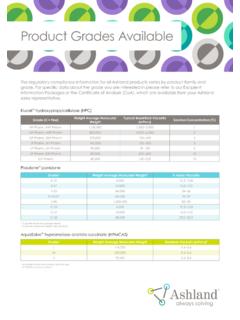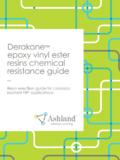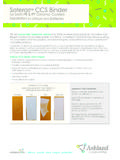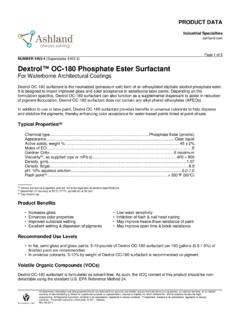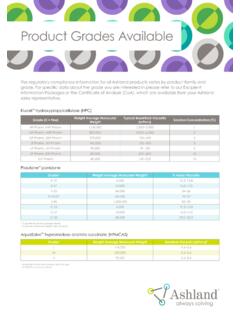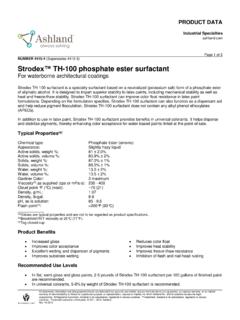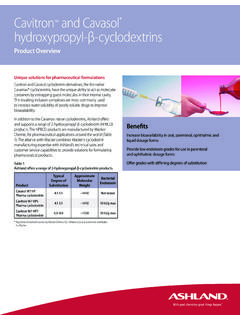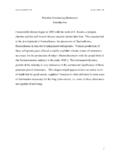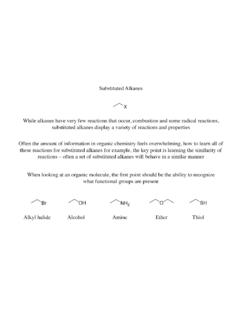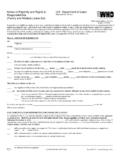Transcription of Klucel hydroxypropylcellulose - ashland.com
1 1 Klucel hydroxypropylcellulosePhysical and chemical properties 2 3 Table of Contents1. Introduction ..4 2. Chemistry ..43. Grades and Viscosity Types..64. Physical Properties..6 Moisture Absorption ..7 Dispersion and Dissolution..7 In Water..7 In Organic Liquids..8 Properties of Solutions..9 Aqueous Solutions..9 Effect of Concentration and Viscosity Type..9 Rheology.. 10 Effect of Temperature on Viscosity ..10 Cloud Point (Precipitation Temperature) ..10 Cloud Point Versus Molecular Weight.
2 10 Effect of pH on Cloud Point.. 11 Polymer Hydration ..11 Effect of pH on Hydration ..11 Effect of Ionic Strengthon Hydration ..12 4. Aqueous Solution Compatibilities ..12 Inorganic Salts.. 12 Organic Materials ..13 Water-soluble Polymers ..13 Effect of Blending with Other Water-soluble polymers ..13 Water-insoluble Polymers ..14 Surfactants ..14 Viscosity Stability of Solutions 14 Hydrolysis and Oxidation 14 Biological Stability ..15 Preservatives.
3 15 Surface and Interfacial Tension 15 Organic Solvent Solution ..15 Effect of Concentration and Viscosity Type..15 Viscosity and Precipitation Temperature ..15 Recommended Defoamers. 16 Melt Rheology ..165. Applications ..17 Tablet Binding.. 17 Modified-release Matrix Former .. 18 Hot-melt Extrusion for Controlled- release Applications ..18 Continuous Granulation.. 19 Film Coatings ..196. Packaging, Regulatory Status, Toxicology, Safety.. 20 Packaging and Shipping ..20 Regulatory Status.. 20 Toxicology.. 20 Product Safety.. 207. References .. 20 Appendix: Methods.
4 21 4 Klucel hydroxypropylcellulose (HPC) is a nonionic water-soluble cellulose ether with a remarkable combination of properties. It combines organic solvent solubility, thermoplasticity, and surface activity with the aqueous thickening and stabilizing properties characteristic of other water-soluble cellulose polymers available from Ashland. Klucel HPC films are flexible without plasticizers and non-tacky at high humidity. The information presented here describes the physicochemical and material properties of Klucel HPC, specific for pharmaceutical applications, as developed in our research and plant facilities. Also included is information about the behavior of Klucel HPC in a number of common pharmaceutical applications.
5 A guide to regulatory status and toxicological studies is provided for convenient reference. The Appendix gives information about the methods used for analytical processes described in this document. To help the reader identify some of the versatile uses for this water-soluble polymer, a representative listing is presented in Table 1. Many of these uses for Klucel HPC are discussed in detail in this document. Additional technical literature is available from your Ashland sales representative by request, or from our website at 1. Typical pharmaceutical uses for Klucel HPCK lucel HPC gradeImmediate-release binder (use level, w/w)Controlled-release matrix (use level, w/w)Film coating (use level, w/w)ELF Pharm2-6%5%EF Pharm2-6%5%LF Pharm2-6%5%JF PharmGF Pharm15 - 35%MF Pharm15 - 35%HF Pharm15 - 35% Klucel HPC is manufactured by reacting alkali cellulose with propylene oxide at elevated temperatures and pressures.
6 The propylene oxide can be substituted on the cellulose through an ether linkage at the three reactive hydroxyls present on each anhydroglucose monomer unit of the cellulose chain. An idealized structure for a portion of a hydroxypropylcellulose molecule with a degree of substitution (DS) of is given in Figure 1. Figure 1. Chemical structure of Klucel hydroxypropylcelluloseThe etherification takes place in such a way that hydroxypropyl substituent groups contain almost entirely secondary hydroxyls. The secondary hydroxyl present in a side chain is available for further reaction with the oxide, and chaining out may take place. This results in formation of side chains containing more than one mole of combined propylene oxide.
7 The added hydroxypropyl group contains a hydroxyl group that also can be etherified during preparation of hydroxypropylcellulose . When this occurs, the number of moles of hydroxypropyl groups per glucose ring, or moles of substitution (MS), can be higher than 3. 1. Introduction2. Chemistry15 - 35% 5 6 Klucel HPC is produced in several grades. Seven viscosity types are available, designated as EL, E, L, J, G, M and H. Product designation is a combination of viscosity type followed by particle size and market segment designation, for example: Klucel HF Pharm HPC; in which the H designates the grade and the F Pharm designates the market as Pharmaceutical. Fine particle size is indicated by an X ( , Klucel MXF Pharm).
8 Some typical viscosity and molecular weight values are given in Table 2. Klucel HPC Viscosity and Molecular WeightConcentration in Water/Brookfield Viscosity (25 C, LVF, Moisture Free; mPa s)Molecular Weight (Daltons)Grade1%2%5%10%HF Pharm15 0 0 30001,150,000MF Pharm4000 6500850,000GF Pharm15 0 4 0 0370,000JF Pharm15 0 4 0 0140,000LF Pharm75 15 095,000EF Pharm300 60080,000 ELF Pharm15 0 3 0 040,000 Klucel HPC is a white to slightly yellow colored, odorless and tasteless powder. Some selected physicochemical properties for Klucel HPC are listed in Table 3. Selected Physicochemical Properties for Klucel SpecificationParticle sizeRegular grades, total through 595 m: 85 to 100%; on 841 m and above: <1%; on 595 m and above: <15%.
9 Fine grades, total through 250 m: ; through 177 m: <90%; through 149 m: <80%.Moles of substitution2 to to 8 Residue on ignition, % temperature, C100 to 150 Burnout temperature, C in N2 or O2450 to 500Tg*, C0 and 120 Lead, ppm max10 Heavy metals, ppm max20 Silica, % of hydroxypropoxy groups, % to * Klucel HPC is a special polymer that can show dual Tg because it has a Physical Properties3. Grades andViscosity Types*Measured by GPC-size exclusion chromatography. Moisture AbsorptionKlucel HPC absorbs moisture from the atmosphere, as do other water-soluble materials. The amount absorbed depends on relative humidity and temperature of the environment. As packed, moisture content of all grades does not exceed 5% by weight, and is generally between 2% and 3%.
10 It is suggested that Klucel HPC be stored in tightly closed containers to prevent any increase in moisture HPC has a low affinity for water. At any given relative humidity (RH), it has a lower equilibrium moisture content than most other water-soluble polymers. Typical values for Klucel HPC are shown in Figure 2. Equilibrium Moisture Contents of Selected Grades of Klucel Dispersion and DissolutionKlucel HPC is soluble in water at room temperature. It is insoluble in water above 45 C. It is readily soluble in many organic solvents, hot or cold. The best methods for preparing solutions of Klucel HPC in water or organic solvents are described in the following paragraphs.
